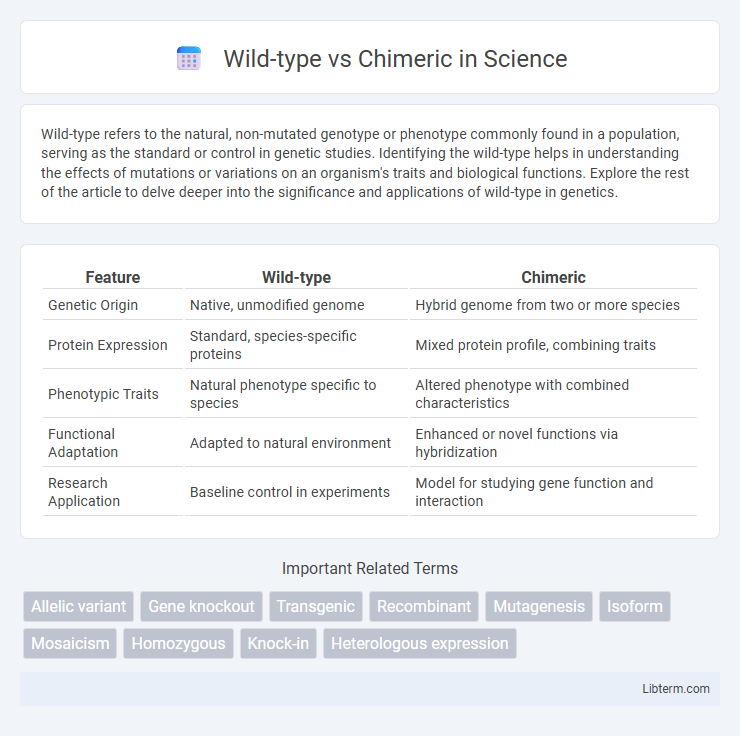Wild-type refers to the natural, non-mutated genotype or phenotype commonly found in a population, serving as the standard or control in genetic studies. Identifying the wild-type helps in understanding the effects of mutations or variations on an organism's traits and biological functions. Explore the rest of the article to delve deeper into the significance and applications of wild-type in genetics.
Table of Comparison
| Feature | Wild-type | Chimeric |
|---|---|---|
| Genetic Origin | Native, unmodified genome | Hybrid genome from two or more species |
| Protein Expression | Standard, species-specific proteins | Mixed protein profile, combining traits |
| Phenotypic Traits | Natural phenotype specific to species | Altered phenotype with combined characteristics |
| Functional Adaptation | Adapted to natural environment | Enhanced or novel functions via hybridization |
| Research Application | Baseline control in experiments | Model for studying gene function and interaction |
Introduction to Wild-Type and Chimeric Concepts
Wild-type organisms or genes represent the natural, non-mutated state commonly found in nature, serving as a baseline for genetic and phenotypic comparison. Chimeric constructs involve combining genetic material from different sources to create novel molecules or organisms with specific, enhanced traits. Understanding the differences between wild-type and chimeric models is crucial for genetic engineering, functional genomics, and biotechnological applications.
Defining Wild-Type: Characteristics and Importance
Wild-type refers to the naturally occurring genotype or phenotype of an organism as observed in its typical environment, serving as the standard reference for genetic studies. It is characterized by unaltered DNA sequences that have evolved to confer optimal survival and reproduction traits under natural conditions. Understanding wild-type organisms is crucial for identifying the effects of genetic mutations, especially when comparing them to chimeric models that contain mixed genetic material from different sources.
Chimeric Variants: An Overview
Chimeric variants combine genetic material from multiple sources, creating novel proteins with enhanced or altered functions compared to wild-type counterparts. These engineered proteins are widely utilized in therapeutic development, including chimeric antigen receptors (CARs) for targeted cancer immunotherapy. Advances in synthetic biology and protein engineering facilitate the design of chimeric molecules with improved specificity, stability, and efficacy in clinical applications.
Structural Differences: Wild-Type vs Chimeric
Wild-type proteins maintain their native amino acid sequences and natural folding patterns, ensuring typical structural conformation and biological function. Chimeric proteins combine domains or sequences from different species or protein families, resulting in hybrid structures with altered folding, stability, and functional sites. Structural differences between wild-type and chimeric proteins significantly impact ligand binding, enzymatic activity, and interaction with other biomolecules.
Genetic Implications and Modifications
Wild-type genes represent the natural, unmodified genetic sequences found within an organism, serving as the baseline for genetic function and expression. Chimeric constructs result from the deliberate combination of genetic material from different species or gene variants, enabling the study of specific gene functions and the development of novel traits. These genetic modifications have significant implications for understanding gene regulation, protein interactions, and for advancing biotechnology applications such as gene therapy and synthetic biology.
Functional Outcomes: Comparing Wild-Type and Chimeric Forms
Wild-type proteins exhibit natural functional properties optimized through evolutionary processes, ensuring consistent biological activity and precise cellular regulation. Chimeric proteins, engineered by combining domains from different sources, often display enhanced or novel functionalities but may also introduce altered stability or unexpected interactions. Functional outcomes depend on domain compatibility and structural integrity, with chimeric forms offering potential benefits in therapeutic targeting and synthetic biology applications.
Research Applications in Science and Medicine
Wild-type and chimeric molecules serve distinct roles in research applications within science and medicine, where wild-type represents the natural, unaltered genetic sequence often used as a baseline in experimental studies. Chimeric constructs, engineered by combining sequences from different species or genes, enable targeted investigations into protein function, gene regulation, and therapeutic interventions such as chimeric antigen receptor (CAR) T-cell therapy in oncology. Employing wild-type and chimeric systems enhances understanding of disease mechanisms and accelerates drug development by providing versatile models for functional and translational research.
Advantages and Limitations of Chimeric Models
Chimeric models offer distinct advantages such as enhanced physiological relevance by incorporating human cells into animal hosts, enabling more accurate disease modeling and drug testing. Limitations include potential immune rejection issues and variability in engraftment efficiency, which can affect experimental reproducibility. These models are invaluable for translational research but require careful design to mitigate ethical concerns and technical challenges.
Ethical Considerations in Chimeric Studies
Chimeric studies raise significant ethical considerations centered on the creation of organisms containing mixed genetic material from different species, which challenges traditional boundaries of identity and species integrity. Issues include potential animal welfare concerns, such as unpredictable health effects and suffering in chimeric animals, and moral questions about human-like cognitive capacities if human cells contribute to brain development. Regulatory frameworks emphasize the importance of strict oversight, transparency, and compliance with guidelines to balance scientific advancement with respect for ethical standards in chimeric research.
Future Perspectives: Wild-Type and Chimeric Developments
Wild-type and chimeric constructs hold transformative potential for future therapeutic and biotechnological applications, with wild-type systems providing foundational stability and chimeric designs offering enhanced functional diversity. Advances in gene editing and synthetic biology enable precise modulation of chimeric molecules to target complex diseases and improve vaccine efficacy. Emerging research focuses on optimizing the balance between natural fidelity and engineered versatility to drive next-generation innovations in personalized medicine and synthetic biology platforms.
Wild-type Infographic

 libterm.com
libterm.com